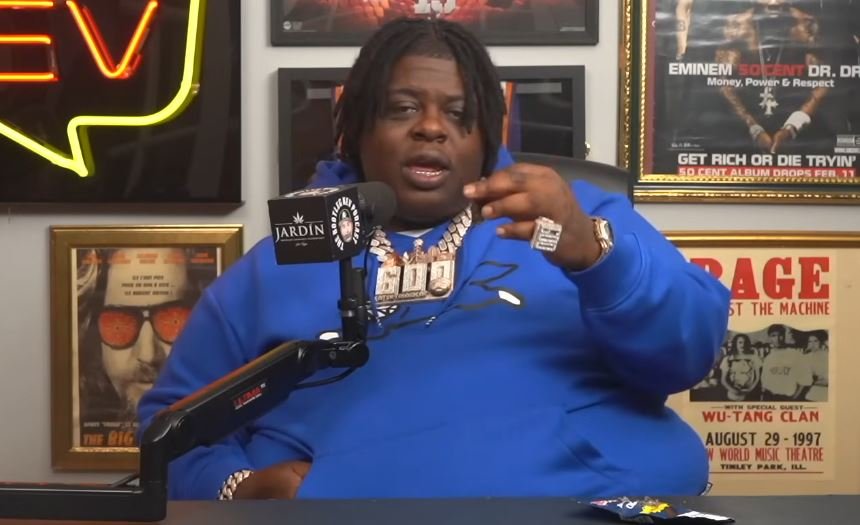
BigXthaPlug’s weight is more than just a figure; it is an integral part of who he is, influencing how he performs, how audiences see him, and how his art conveys unadulterated genuineness. His image as a heavyweight presence in hip-hop is anchored by his bulk, which has become more of a symbol than a number. He is tall, weighing an estimated 330+ pounds. Like a swarm of bees creating both power and order by sheer force, his mass and demeanor work together to make something larger than life.
His past gives him a remarkable depth. In his youth, his build was a noted advantage, pushing him to football glory in Dallas. He squatted 455 pounds, bench-pressed 355 pounds, and was praised for his strength. His rap persona is fueled by the same mass that was formerly developed for sports. He turned personal failures into stepping stones by writing poems on medical documents while incarcerated, cut off from the sport and the classroom. His size added an additional element to this turnaround, which is reminiscent of other artists who have used adversity as fuel. This shows that he is resilient in addition to being well-known.
Big X Tha Plug – Personal and Professional Profile
| Attribute | Details |
|---|---|
| Real Name | Xavier Landum |
| Stage Name | BigXthaPlug |
| Date of Birth | May 12, 1998 |
| Age | 27 years (as of 2025) |
| Birthplace | Dallas, Texas, United States |
| Height | Estimated 6’2” |
| Reported Weight | 330–350+ pounds (varies, sometimes speculated higher) |
| Education | Crown College, Minnesota (former student-athlete, expelled) |
| Early Career | High school football standout, transitioned to music after incarceration |
| Occupation | Rapper, songwriter, record producer |
| Genres | Hip-hop, Southern hip-hop, trap, country rap |
| Record Label | UnitedMasters, 600 Entertainment |
| Notable Songs | “Texas,” “Mmhmm,” “The Largest,” “2AM,” “Therapy Session” |
| Awards/Recognition | “Texas” certified Gold by RIAA, Billboard Hot 100 charting singles |
| Children | One son, Amar (age 6), shared publicly his autism journey |
| Public Perception | Celebrated for large build, gritty voice, and authentic Texas imagery |
His weight provokes debate and frequently divides supporters. His admirers see it as a sign of his power and endurance and as part of his appeal. Critics fear it could shorten his life, comparing him to Big Pun, who passed away at the age of 28 from weight-related issues. The contradiction is unavoidable—celebration of power combining with concern for health. However, his intensely animated and incredibly powerful performances always demonstrate that artistic ability is not constrained by stature.
His perception of his body is culturally related to more general hip-hop customs. From Rick Ross prior to his metamorphosis to Fat Joe, big-bodied rappers have been accepted as symbols of toughness and genuineness. BigX carries on this tradition, but with a uniquely Texas twist. He redefines masculinity in rap by unabashedly embracing his size, demonstrating that power can take many forms. In recent years, as society debates body positivity, his presence becomes particularly beneficial—proof that hip-hop, too, is part of the conversation.
His music videos are also symbolic. Fans pointed out that he didn’t ride in “Texas,” presumably due to weight-related practical considerations, but he did appear next to horses. However, even omissions gain significance in a genre that relies heavily on imagery and symbolism. They draw attention to how, when size is a component of identity, every little detail—every image, every movement—is emphasized.
There is no denying that health comes up frequently. Hip-hop history contains warning stories about anything from obesity-related disasters to successful metamorphoses like Gucci Mane’s. BigX has alluded to fitness objectives, but acknowledges that his lifestyle choices make striking a balance challenging. His narrative tells us that fame intensifies pressure, particularly surrounding image, health, and stamina. Fans say they hope he finds balance—maintaining his presence while guaranteeing durability—rather than losing his identity.
BigX provides glimpses into his humanity outside of his body, especially as a father. He transcends preconceptions with his open conversations about parenting a son with autism, including partnerships with the Autism Society of America. The same man who represents ferocity on stage embraces softness at home. This difference makes the debate about his weight less judgmental and more layered—it becomes about wanting him to thrive, both as an artist and as a father.
Jelly Roll, another big-bodied performer who transformed vulnerability into art, comes to mind when comparing him to others. In a similar vein, Boogie2988 on YouTube included weight into his persona before changing it. These parallels make BigX’s trip immensely malleable for interpretation: is his size a theatrical prop, a personal issue, or both? The solution, perhaps, is all of the above.
